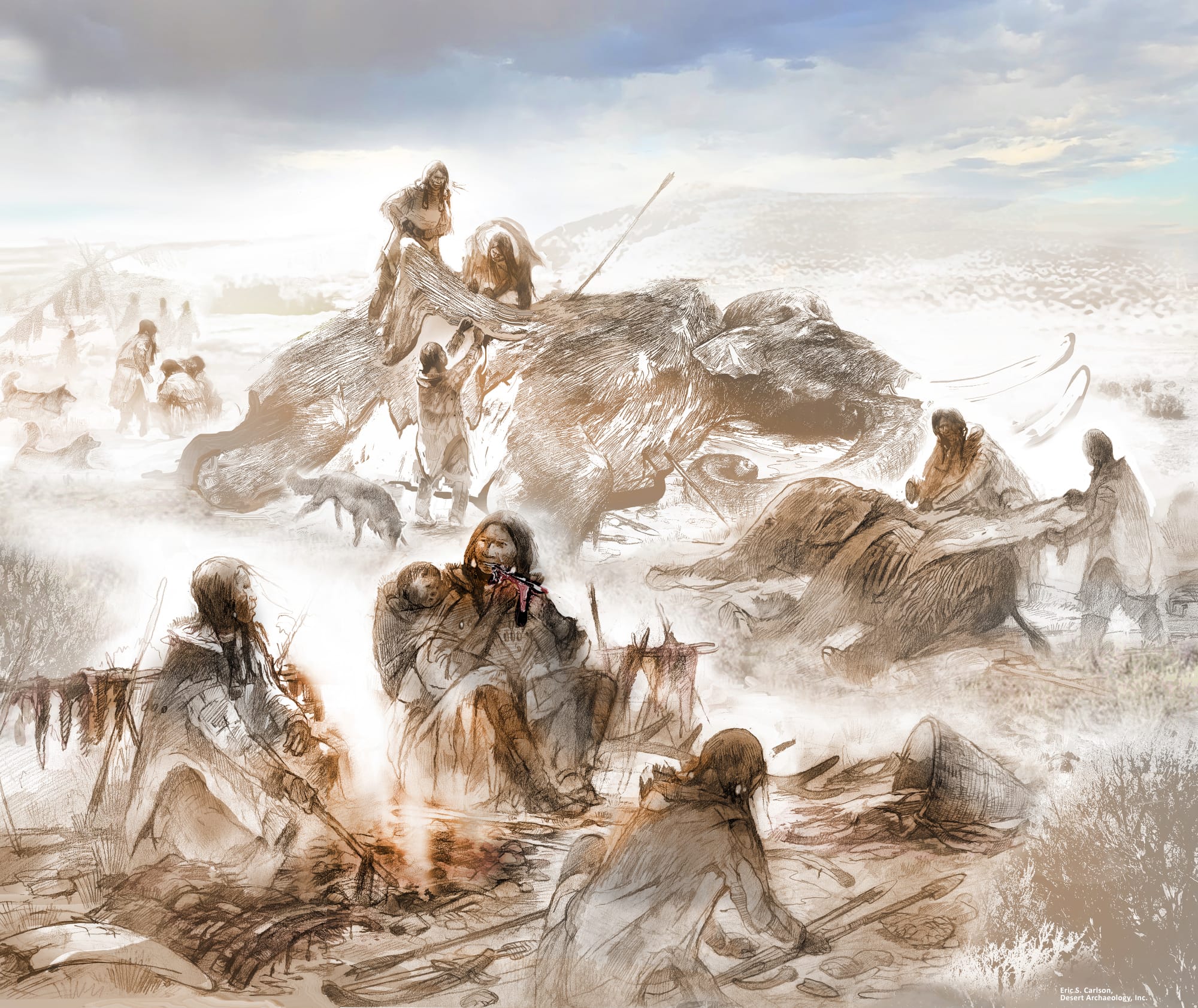Welcome back to the Abstract! This week, mammoth is the main item on the menu—or at least, it was 13,000 years ago in Montana. Scientists reconstructed the diet of a mother who ate like a scimitar-tooth cat and nursed her infant, whose bones are the last human remnant of a once expansive population.
Then, a team delivers a blow to the dream of a habitable Venus, even as another team demonstrates that the early solar system was awash in watery mist. Last, there are spiders using their webs as slingshots, and you ought to know about it. Enjoy!
The Son of the Mammoth-Eaters
Some 13,000 years ago, a group of dynamic hunter-gatherers rapidly swept south across North America, which was then a landscape of receding glaciers and gigantic game, like mammoths and American camels. These peoples, known today as the Clovis culture, left behind a wealth of archaeological remains, such as camps filled with tools, sharp weapons, and the butchered remains of their prey (including the Wyoming site mentioned in last week’s story about bone needles).
But though signs of this enterprising culture are scattered across the continent, only one Clovis individual has been discovered and identified so far in the archaeological record. Anzick-1, who is named after the Montana burial site where he was carefully interred by his people, was between the ages of one and two when he died some 12,900 years ago. His remains have inspired a series of discoveries, especially once he became the first ancient Native American to have his genome fully sequenced about a decade ago. In the wake of that major breakthrough, Anzick-1 was laid to rest again as part of an intertribal burial ceremony during the summer of 2014.
Now, scientists have resolved a major question about the Clovis culture from samples of Anzick-1’s skull, a project that was conducted “in consultation with and support of regional Native American tribes in Montana and Wyoming” according to a new study. It’s clear that these ancient peoples hunted mammoths, but scientists have sparred about the extent to which the Clovis diet centered on extinct proboscideans compared to other available food sources.
“Some researchers contend that Clovis populations were megafaunal specialists to some extent, focusing particularly on mammoth (Mammuthus columbi), while others have argued that such an adaptation was not viable, and thus, Clovis populations were more likely broad-spectrum foragers, regularly incorporating in their diet small game, plants, and perhaps fish,” said researchers co-led by James Chatters of McMaster University and Ben Potter at the University of Alaska Fairbanks.
“The resolution of this debate has profound implications for reconstructing the adaptive strategies that allowed rapid expansion of Paleoindians throughout the Western Hemisphere and assessing the impact of that expansion on megafaunal extinctions during the terminal Pleistocene,” the team said.
In other words, the Clovis diet can shed light on how these people managed to spread across immense distances within a few centuries, while also helping to resolve the controversy over the role played in megafaunal extinctions that occurred across the Americas at the tail end of the last Ice Age.
To that end, the team analyzed the elemental composition of Anzick-1’s bones for clues about what he ate before his early death. The results reveal that he was mostly breastfed, while eating some supplementary meat, a discovery that amazingly opens a window into his mother’s diet while she was nursing him.
As it turns out, Mama was a mammoth-eater. Subtle isotopic differences in the skull sample indicate that her meals overwhelmingly consisted of mammoth meat, though she likely also ate elk, bison, and Camelops, an extinct North American camel. Her diet is a close match to scimitar-tooth cats that still prowled the continent at this time, according to the study.
“Anzick-1’s maternal diet can be directly compared with diets of other secondary consumers that occupy specific niches and have preferred prey,” the team said. “She is most similar to Homotherium, the scimitar-tooth cats, widely interpreted as juvenile mammoth specialists.”
“While we do not interpret the results from this one individual as bearing directly on the cause(s) of widespread megafaunal extinctions in the Americas at the Pleistocene/Holocene boundary, we do suggest that predation of some megafaunal species by Clovis populations with effective distance weapons may have played a role,” the researchers added. “The loss of this taxon may have played a role in behavioral shifts and the end of Clovis as a distinct cultural tradition in the Americas.”
It is incredible that tiny isotopes in the fragmented skull of a small child can expose macro insights about the sudden obliteration of ancient colossal creatures. But this study also presents an intimate image of a mother nursing her child more than a dozen millennia ago, a timeless act of bonding that left elemental traces of her milk in his bones. Anzick-1 sadly didn’t get to live a long life, but he does have an extraordinary afterlife as the sole corporeal representative of a vast and sprawling culture.
It reminds me of the following quote from the archaeologist Kathryn Denning, which speaks to the limitations we face in connecting with people of the past.
“What can be said from the vantage point of archaeology is that there is wisdom in knowing the empty spaces—in knowing the difference between what we might someday recover and what we never will ” Denning said in her essay “Impossible Predictions of the Unprecedented.”
“We will never see an ancient parent’s smile or hear their child’s laugh, except in a dream. We must simply live with that silence. Once in a long while, we discover small red handprints on a cave ceiling that tell us that long ago, a 5-year-old was once lifted up on someone’s shoulders to reach up high, or we find a carefully made toy which bears the marks of baby teeth. Those traces of love and laughter have to be enough.”
Visions of a Venusian Ocean Fade into a Mirage
Bad news this week for anyone invested in the dream of a once-habitable Venus (ahem: me). Scientists studied the atmospheric composition of Venus’s atmosphere to search for clues about water content in its interior. Their results suggest that Venus is internally desiccated, and probably has been for most of its history, casting doubt on longstanding hopes that our neighboring world hosted liquid water oceans billions of years ago.
“A dry Venusian interior is not consistent with Venus having had surface oceans or, by extension, a conventionally habitable climate,” said researchers led by Tereza Constantinou of the University of Cambridge. “These results indicate that Venus probably never experienced conditions conducive to ocean condensation.”
“Consequently, Venus-like exoplanets or planets within the Venus zone, which the James Webb Space Telescope can characterize, are unlikely to be cool enough to condense liquid water if they formed in situ,” the team added. “This makes these planets improbable candidates for liquid-water habitable conditions.”
You have to hand it to Venus: It seems really committed to inhospitality.
A Giant Misty Splash Park in the Early Solar System
The Venus story was the shot, but here’s a watery chaser. Another study this week tackled the unsolved mystery of how Earth, and worlds like it, end up hosting liquid water, which is the most essential catalyst for life as we know it.
One major hypothesis is that Earth received its water primarily from hydrated asteroids that struck its surface more than four billion years ago. But scientists have now proposed an alternate mechanism; as icy asteroids warmed in the early solar system, they sloughed off clouds of sublimated gas that soaked Earth and other worlds, with no need for direct impacts.
“We propose that primordial asteroids were icy and that when the ice sublimated, it formed a gaseous disk that could then reach planets and deliver water,” said researchers led by Quentin Kral of the Paris Observatory. “Our model shows most of the water being delivered between 20 and 30 million years after the birth of the Sun, when the Sun’s luminosity increased sharply.”
“This offers a new mechanism capable of transporting water to the inner planets in the Solar System,” the team added. “It may even be universal across all exo-planetary systems with respect to habitable-zone planets.”
If this hypothesis is confirmed by future observations, it would certainly boost the odds that watery worlds are common in the universe. The study also gets extra points for the phrase “ten terrestrial oceans of water” which sounds like an ingredient you’d find in a major deity’s recipe book.
A Test of Real-Life Spidey Senses
Spiders are well-known for their web-spinning talents, which allow them to catch prey in their deadly silk threads. Most web-spinners lie in wait for a catch, but ray spiders (Theridiosomatidae) play a more active role by pulling their webs into tense conical shapes that they then release to capture prey like a slingshot.
Scientists took a closer look at this ingenious hunting strategy by filming ray spiders reacting to simulated insect noises as well as live mosquitos that were “tethered to very thin strips of black construction paper attached to the abdomen or hind legs using a small dab of gel SuperGlue” (this is the only time I have ever felt a little sorry for a mosquito).
The results show that ray spiders pick up on airborne signals from their incoming victims, triggering them to release the nets at high speeds to actively ensnare prey that might otherwise evade capture.
“Given that static webs can pick up airborne sounds, it is plausible that spiders hunting in these webs might also discern useful information about the approach, size and/or behaviors of flying insects before they impact webs,” said authors Sarah Han and Todd Blackledge of the University of Akron. “If this hypothesis is correct, such information could significantly improve the odds of spiders successfully capturing prey.”
It’s definitely worth taking a look through the study, which includes videos and pictures of the spiders in action.
Thanks for reading! See you next week.

